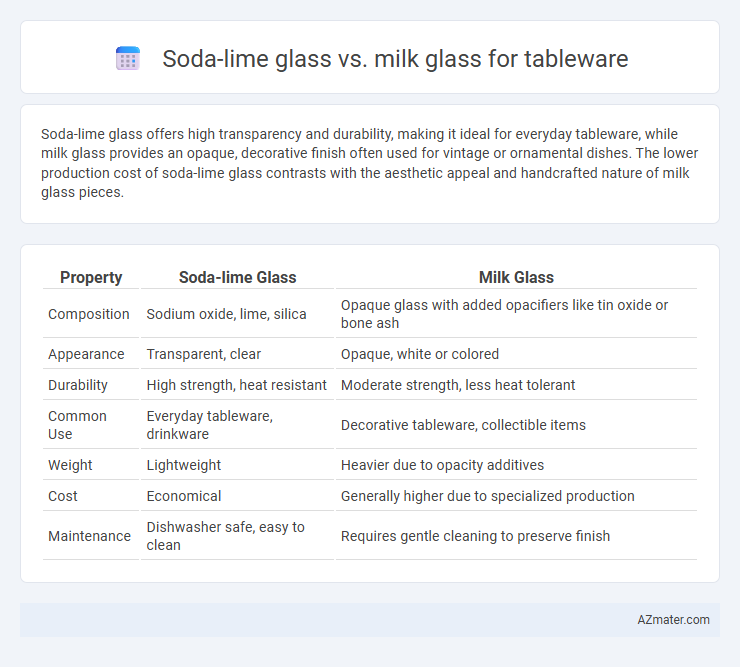Soda-lime glass offers high transparency and durability, making it ideal for everyday tableware, while milk glass provides an opaque, decorative finish often used for vintage or ornamental dishes. The lower production cost of soda-lime glass contrasts with the aesthetic appeal and handcrafted nature of milk glass pieces.
Table of Comparison
| Property | Soda-lime Glass | Milk Glass |
|---|---|---|
| Composition | Sodium oxide, lime, silica | Opaque glass with added opacifiers like tin oxide or bone ash |
| Appearance | Transparent, clear | Opaque, white or colored |
| Durability | High strength, heat resistant | Moderate strength, less heat tolerant |
| Common Use | Everyday tableware, drinkware | Decorative tableware, collectible items |
| Weight | Lightweight | Heavier due to opacity additives |
| Cost | Economical | Generally higher due to specialized production |
| Maintenance | Dishwasher safe, easy to clean | Requires gentle cleaning to preserve finish |
Introduction to Soda-Lime Glass and Milk Glass
Soda-lime glass, composed primarily of silica, soda, and lime, is the most common material used for tableware due to its durability, affordability, and excellent clarity. Milk glass, a type of opaque or translucent glass with a white, milky appearance, is created by adding certain metal oxides during production, making it popular for decorative and vintage-style tableware. Both materials offer unique aesthetic and functional qualities suited to different dining settings and preferences.
Composition and Manufacturing Differences
Soda-lime glass, primarily composed of silica, sodium oxide, and calcium oxide, is manufactured through melting raw materials at high temperatures, resulting in a transparent, durable tableware ideal for everyday use. Milk glass incorporates additional opacifying agents like tin oxide or bone ash during production, giving it an opaque, milky-white appearance favored for decorative and vintage-style tableware. The manufacturing of milk glass requires controlled cooling and precise blending of additives to achieve uniform opacity, contrasting with the simpler process of soda-lime glass.
Visual Appearance and Aesthetic Appeal
Soda-lime glass features a clear, transparent quality that enhances the vividness of colors and patterns on tableware, providing a sleek and modern aesthetic ideal for showcasing food presentation. Milk glass, characterized by its opaque, milky-white appearance, offers a vintage and elegant look that adds a soft, diffused glow to table settings, often evoking a classic or nostalgic charm. The choice between soda-lime and milk glass ultimately depends on the desired visual impact, with soda-lime providing clarity and brightness, while milk glass delivers a timeless, decorative appeal.
Durability and Strength in Daily Use
Soda-lime glass exhibits higher durability and strength in daily use due to its chemical composition tailored for resistance to thermal shock and impact, making it ideal for frequent handling and washing. Milk glass, while aesthetically pleasing with its opaque finish, is generally more brittle and prone to chipping or cracking under stress, limiting its practicality for everyday tableware. Selecting soda-lime glass ensures long-lasting performance and resilience, crucial for active household environments.
Safety and Food Compatibility
Soda-lime glass is highly safe for tableware due to its chemical stability, non-toxicity, and resistance to leaching harmful substances into food or beverages, making it ideal for everyday use. Milk glass, while aesthetically pleasing with its opaque finish, often contains additives like lead or other heavy metals that can pose health risks if the glassware is chipped or improperly manufactured. For optimal food compatibility and safety, soda-lime glass remains the preferred choice, complying with strict FDA regulations for food-contact materials and ensuring no harmful interaction with acidic or hot contents.
Heat Resistance and Microwave Safety
Soda-lime glass offers moderate heat resistance and is generally safe for microwave use, making it a practical choice for everyday tableware. Milk glass, composed primarily of soda-lime glass with added opacifiers, has similar heat resistance but may vary in microwave safety depending on decorative elements and thickness. For reliable microwave heating, soda-lime glass typically outperforms milk glass due to fewer heat-induced stresses and consistent thermal properties.
Maintenance and Cleaning Guidelines
Soda-lime glass tableware requires gentle cleaning with non-abrasive detergents to avoid surface scratches and should not be exposed to sudden temperature changes to prevent cracking. Milk glass, known for its opaque finish, benefits from hand washing with mild soap and warm water to maintain its delicate appearance and avoid discoloration or dullness. Avoid using harsh chemicals or abrasive scrubbers on both materials to preserve their longevity and visual appeal.
Cost Comparison and Market Availability
Soda-lime glass is widely used in tableware due to its low production cost and abundant market availability, making it an economical choice for everyday use. Milk glass, characterized by its opaque, milky appearance, is generally more expensive because of its specialized manufacturing process and limited production scale. The broader distribution and lower price point of soda-lime glass contrast with the niche appeal and higher retail cost of milk glass in tableware markets.
Environmental Impact and Recyclability
Soda-lime glass, composed primarily of silica, soda ash, and lime, offers superior recyclability due to its widespread acceptance in recycling programs and lower energy requirements for melting compared to other glass types. Milk glass, containing additives like barium or zinc oxide to achieve its opaque appearance, poses challenges in recycling facilities, often leading to contamination in clear glass recycling streams and limited reuse potential. Environmentally, soda-lime glass proves more sustainable by enabling efficient recycling cycles and reducing landfill waste, whereas milk glass's specialized composition results in higher environmental impact through increased disposal and energy consumption.
Choosing the Best Glass for Your Tableware Needs
Soda-lime glass is popular for tableware due to its durability, affordability, and transparency, making it ideal for everyday use and clear presentations. Milk glass, distinguished by its opaque white appearance and vintage charm, suits decorative or formal tableware where aesthetic appeal and uniqueness are prioritized. Choosing between soda-lime and milk glass depends on balancing practicality, style, and specific usage scenarios, with soda-lime excelling in versatility and milk glass favored for artistic or statement pieces.

Infographic: Soda-lime glass vs Milk glass for Tableware
 azmater.com
azmater.com